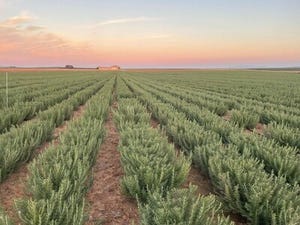Peas, pea products an attractive source of dietary protein for broilers
Peas typically contain about 24% crude protein compared to 44% for soybean meal and 36% for canola meal.
April 22, 2024

New research finds that peas and pea products offer broiler chicken producers an attractive source of dietary protein with potential gut health benefits. Pea protein concentrate (PPC), in particular, can reduce reliance on soybean meal without impacting performance or health. Whole peas, PPC, and pea hulls also contain fermentable carbohydrates and fiber that appear to provide prebiotic effects supporting a diverse, healthy intestinal microbiota.
Hybridized as "feed peas" since the 1980s, white-flowered strains of Pisum sativum are versatile, low-tannin, low-antitrypsin legumes that require as little as 60 days to reach bloom stage and 100 days to mature and dry. Seedlings have considerable frost-resistance for planting as a winter crop in warmer areas or as a spring crop in colder regions. Peas have many applications as feedstuffs for many species, fed raw or processed to improve nutritional value.
Peas typically contain about 24% crude protein compared to 44% for soybean meal and 36% for canola meal, known as "double-zero" rapeseed meal in Europe where there is extensive use of peas in poultry diets. Previous studies show that broiler diets can contain up to 30% peas without hurting growth or carcass characteristics.
Besides whole peas, PPC and pea hulls can function as feedstuffs for other species, while there is a lack of published data on their use in broiler diets. As a protein source, peas and PPC usually require amino acid supplementation, particularly for methionine. However, previous research points to the importance of other dietary components of peas, PPC, and hulls -- fiber in the form of indigestible carbohydrates such as nonstarch polysaccharides.
Such dietary fiber may provide a prebiotic effect in the poultry hind gut where commensal bacterial fermentation breaks it down into lactate and short-chain fatty acids, including butyric acid. Its salt form, butyrate, is a primary energy source for intestinal tissues to produce immune cells and enhance immune response. Short-chain fatty acids also help inhibit intestinal colonization of human-pathogenic salmonella and other bacterial pathogens while promoting a healthy intestinal microbiota.
In this study, researchers based in Germany studied the effects of different proportions of peas, PPC, and hulls in pelleted broiler rations, measuring growth performance, carcass characteristics, and changes in intestinal microbiota. They particularly wanted to tease out whether the known effects of feeding peas stemmed from individual constituents -- protein, starch, fiber -- or from "the totality" of the feedstuff.
The researchers formulated 20 diets with varying proportions of peas and pea coproducts (PPC and hulls), which were fed to 800 male Aviagen Ross 308 broilers from day 1 to day 34. They used short-chain fatty acid analysis and 16S rRNA gene code sequencing to examine the ileal and cecal microbiota of selected feeding groups.
The researchers followed conventional complete feed formulation based on the recommendations of the breeding company, using soybean meal in the control diets. In the test diets, they adjusted metabolizable energy to amino acid ratios in two phases covering starter and grower diets. Thus, in each phase they tested 10 isoenergetic and isonitrogenic diets with different proportions of peas and pea products. For better comparability, they determined mixing ratios of peas and pea products so that each experimental diet contained comparable pea protein and pea neutral detergent fiber.
"While the isolated variants were intended to help clarify the influence of peas, pea protein, and pea fiber," the researchers stated, "the combined variants with PPC and PH (hulls) focused on the effect that can be achieved without the pea starch, especially the (digestion) resistant starch."
Overall, the researchers reported, "fattening performances were at a high level." They noted that use of peas and pea products had no adverse effect on growth performance or carcass characteristics, including weights of thighs, breast and wings with skin, and abdominal fat.
They also reported that microbiota composition and ileal bacterial metabolites were unchanged. However, they found microbiota changes in the cecum between dietary treatments for several subdominant microbial genera that preferentially ferment carbohydrates.
The researchers concluded that peas, PPC, and hulls are "well-suited as feedstuffs for feeding broilers when used appropriately." Furthermore, they said, intestinal microbiota responded, "with an increased abundance of nonpathogenic genera that may help maintain intestinal microbial homeostasis."
You May Also Like



